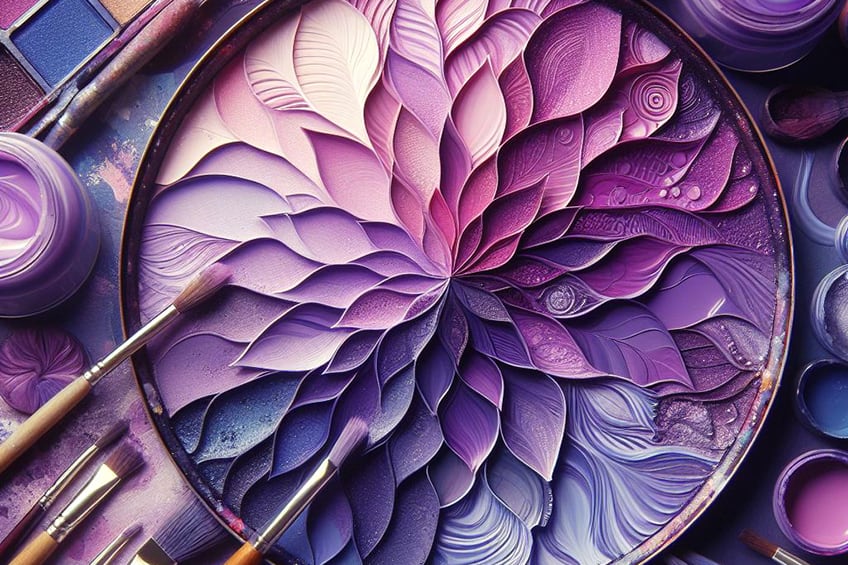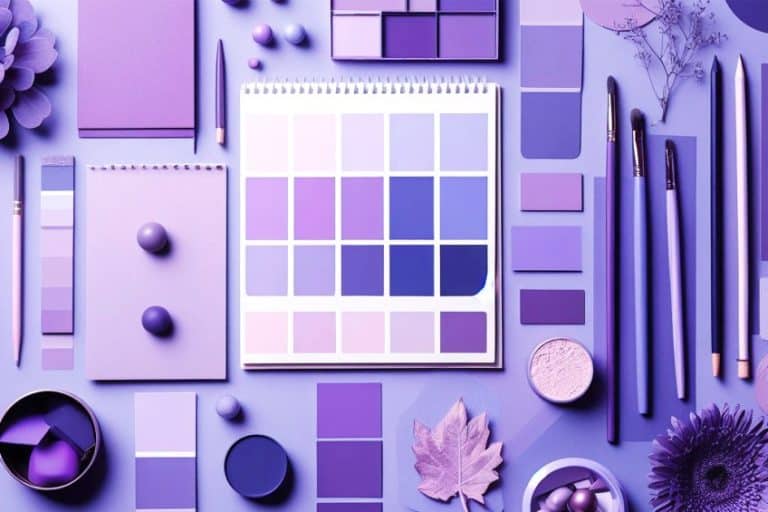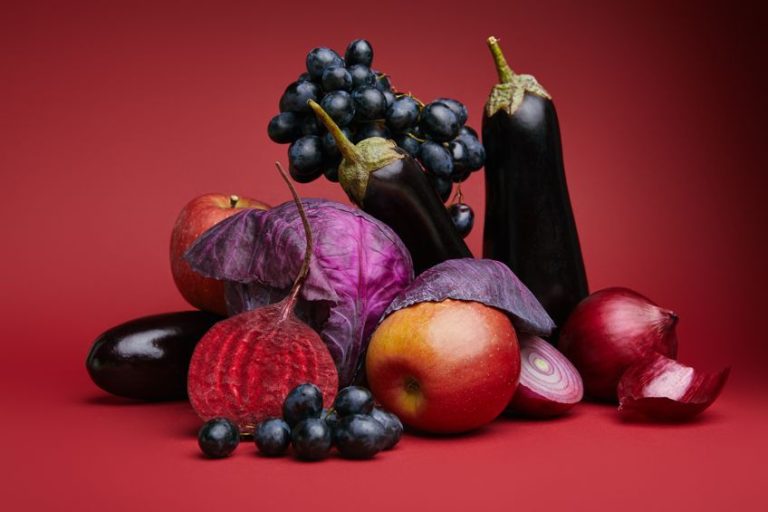Meaning of the Color Purple – The Power of Purple
Each color has a unique effect on the lives of individual people, but the feelings that are produced by each color can vary based on different cultures and experiences. Purple is the color of creativity, spiritualism, and the supernatural. The color of purple is also made up of two primary colors, red and blue, and is effective in balancing the stimulation of red and the calmness of blue. In this article, we will be speaking more about the meaning of the color purple!
Meaning of the Color Purple
| Shade | Hex Code | CMYK Color Code (%) | RGB Color Code | Color |
| Purple | #800080 | 0, 100, 0, 50 | 128, 0, 128 |
What is purple symbolism? In other words, what is the meaning of purple and how does it make a person feel? Purple is a color that hardly ever appears in nature, making it an intriguing and rare color. The meaning of the color purple includes luxury, power, creativity, ambition, royalty, and wisdom. However, it can also represent wealth, pride, peace, magic, independence, and extravagance, and is also subject to color psychology, which indicates that it can have a very powerful impact on people’s behaviors and moods.
Purple is a cheerful and playful color and is associated with getting away from reality. The color purple also makes a statement of independence and is associated with bravery.

When applied professionally it conveys lofty goals and high values. Purple can be offensive to those of a humbler existence and can convey feelings of condescension and arrogance. When applied professionally purple can be a little unsettling and uncomfortable to others. Let us now consider a list of some of the positive and negative qualities of the color purple.
Positive Traits of the Color Purple
- Creativity
- Mystery
- Compassion
- Wisdom
- Uplifting
- Inspiration
- Encourages
- Growth
- Fantasy
- Luxury
Negative Traits of the Color Purple
- Immature
- Emotional
- Overly vigilant
- Arrogant
- Sensitive
- Eccentric
Psychological Meaning of the Color Purple
The psychology of the color purple is relatively complex as it is not a primary color. Purple is a secondary color that combines red and blue. Purple also comes in different tones and shades that will affect the emotional impact it has on our lives.
Depending on what shade of purple it is, it can symbolize creativity, power, and mystery. However, it can also communicate ideas of magic, mystery, spirituality, and depth.
The psychology of purple can also vary with different cultures, and people will view various shades of purple on what they experience and how they were brought up. Psychology associates purple with royalty and luxury, but it can also be a symbol of compassion and bravery.
Purple and Perception
According to color psychology, all shades of color have a marked impact on our feelings as well as on our brains. Different shades of purple can influence our perception and stimulate that part of the brain that is connected to creativity because purple is so unique.

Softer shades of purple can create a calming effect due to the undertone of blue, however, it can also be associated with concepts of warmth and compassion. Darker shades of purple may create different emotions like mystery and fear. This means that the reaction to purple will depend on the specific shade as well as the context.
Purple, Spirituality, and Wisdom
Due to the mysterious nature of the color purple, it is often associated with spirituality and has frequently been connected with the supernatural, the divine, and the unknown. Purple can produce different spiritual meanings with different shades of color.
Softer shades of purple have been related to compassionate energy, and light-heartedness, while darker shades have been connected with sadness and frustration.
Purple, Bravery, and Courage
In some parts of the world, especially in the United States, purple has been associated with bravery, where the highest honor of a Purple Heart medal is awarded to people who have shown extremes of bravery and courage as soldiers in battle.
Purple, Creativity, and Individuality
As purple rarely appears in nature, it is often referred to as unique, exotic, and innovative, and can often inspire creativity. Having something with you that is purple, can spark new ideas, including the passion that is required to bring those very same ideas to fulfillment.
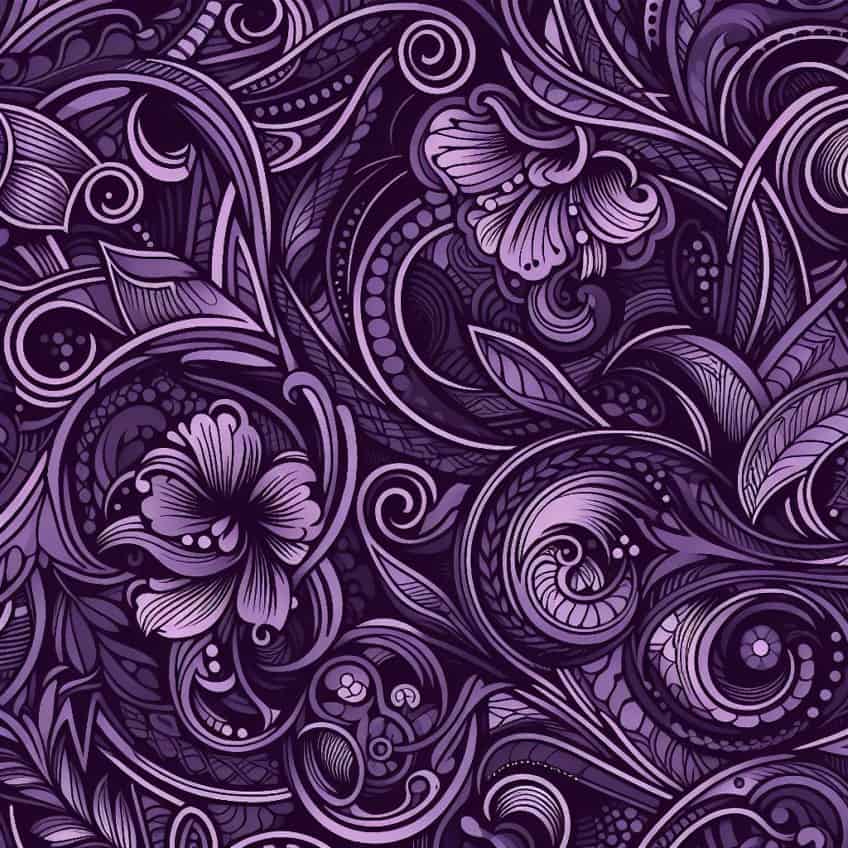
Royalty and Luxury
The most common association that people have with the color purple is royalty and luxury, which comes from the history of the color. Over the centuries, only people of wealth and nobility were permitted to wear purple.
On certain occasions, a particular shade of purple can convey sophistication and indulgence, but can also be recognized as being arrogant.
Compassion and Femininity
Because the color purple is worn more by women than men, it is seen more as a feminine color. Certain shades of purple have also been associated with women’s liberation and suffrage. Paler shades of purple are also associated with romance and compassion.
Uncertainty and Mystery
Due to the purple color’s scarcity in nature, it has often been associated with the unknown, which is very evident in science fiction movies and literature. In certain parts of the world, it has been connected to the afterlife and death, both of which are very uncertain.
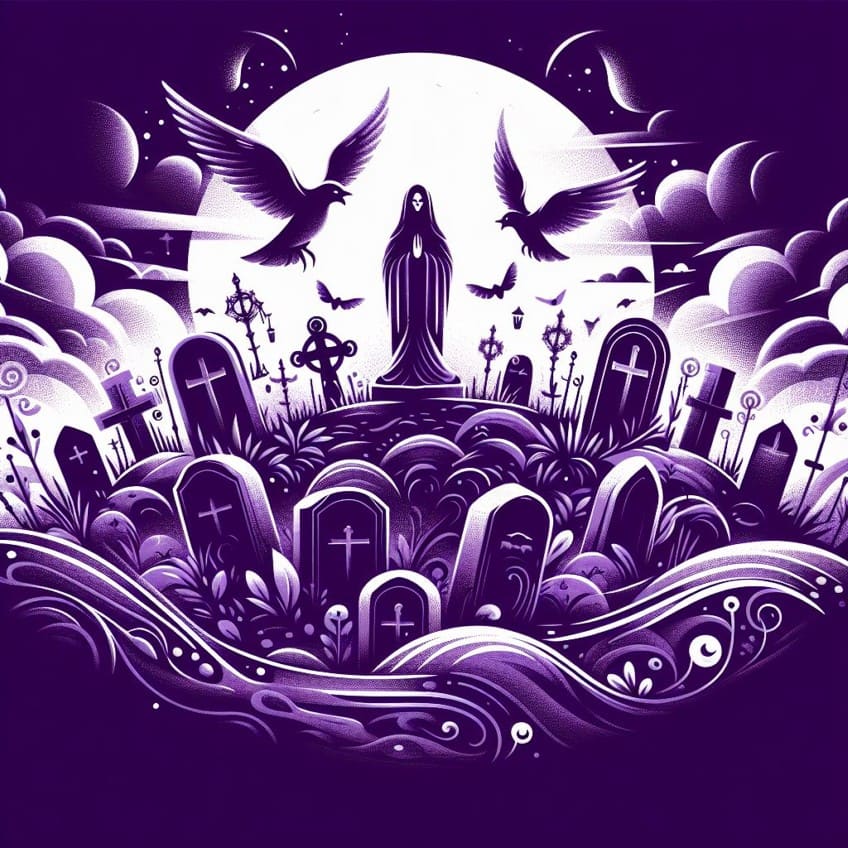
Personality Traits Associated With the Color Purple
The color purple is often associated with wisdom, and people who are drawn to it can have a strong desire for individuality and self-expression. They can possess a vivid imagination and a deep sense of intuition, and if purple is your favorite color, you may recognize some of these personality traits in your life.
- You spend most of your time thinking, living in a fantasy world, and not paying much attention to detail.
- A purple personality may find it difficult to accept other people’s beliefs and ideas.
- These types of personalities enjoy luxury and strive for the best.
- Your high expectations can make you critical of yourself and others.
- Often, the idealistic views you may have are not always practical.
- You find it difficult to ask for help and find it not easy to admit you made a mistake.
- Purple personalities are sensitive, which means you can easily be hurt or take offense.
- If purple dominates your life, you may think of yourself being a very spiritual person.
Physical Effects of Purple
The color purple not only has amazing psychological benefits, but it also has some physical effects that can be utilized to help keep our bodies in good health. Purple has a calming effect that can influence our minds and bodies, as the blue undertones can ensure a very soothing effect that can lower our blood pressure and heart rate, helping to prevent things like heart attacks.

Purple foods have some amazing health benefits as they abound in dietary fibers, minerals, and vitamins, and are very effective in combating inflammation and cardiovascular disease. Purple-colored foods are high in antioxidants that can prevent strokes and cancer. Here are a few examples of purple-colored foods.
- Purple grapes: This fruit contains phytonutrients that assist in preventing high cholesterol and cancer.
- Plums: This fruit contains antioxidants that will improve your bone health, reduce inflammation, enhance digestion, and can also help to reduce blood sugar levels and blood pressure.
- Beetroot: This vegetable has anti-inflammatory properties and can help in lowering blood pressure and improve the heart rate, beetroot can also help to prevent cancer and improve stomach health, and digestion.
- Eggplant: This vegetable is very rich in phytochemicals and antioxidants and can help to prevent liver damage due to its polyphenol content and can also help to prevent asthma and improve inflammatory conditions.
The Color Purple in Different Cultures
When we look at color psychology, we find that each color has a marked influence on our impressions and behavior. However, the perception and interpretation of colors are determined by every person’s culture, traditions, and personal experiences. The symbolic significance of the purple color can vary greatly from royalty to mystery, to spirituality, and power. Let us now consider how some cultures and traditions interpret the color purple.
The most common interpretation of purple in most Eastern and Western cultures is power, wealth, royalty, and fame. In the past, the dye for the color was extremely rare, and as a result, only kings, queens, and rulers wore purple clothing.
Black is the traditional color for grieving and death in many cultures, and purple imparts the same meaning in many European nations including the United Kingdom, Brazil, Italy, India, some African cultures, and Thailand. In Brazil, it is considered unlucky not to wear purple when attending a funeral.

Purple is also linked to mysticism and spirituality in various cultures, and in some traditions is regarded as sacred. It is associated with higher consciousness and wisdom, which is very evident in the Hindu culture, where purple is linked with the crown chakra. This chakra represents enlightenment and spiritual connection.
- China: In some Eastern countries, purple is associated with divinity, immortality, and nobility.
- Egypt: Purple symbolizes faith and virtue and is worn by women to show respect for their traditions.
- Thailand and Brazil: In these countries, purple is a symbol of mourning and death.
- Africa: In many African nations, purple is considered a color of royalty and prosperity. It can also be a color of femininity.
Purple also plays a role in various religions. In Hinduism, purple symbolizes wisdom and peace. When considering Judaism, purple symbolizes redemption through God, and in Catholicism, purple is associated with Lent and Advent.
Meaning of the Shades of Purple
| Shade | Hex Code | CMYK Color Code (%) | RGB Color Code | Color |
| Purple | #800080 | 0, 100, 0, 50 | 128, 0, 128 | |
| Lavender | #a689e1 | 26, 39, 0, 12 | 166, 137, 225 | |
| Violet | #8f00ff | 44, 100, 0, 0 | 143, 0, 255 | |
| Lilac | #c8a2c8 | 0, 19, 0, 22 | 200, 162, 200 |
Purple has many different tones and shades, each one having its unique symbolism and characteristics. Lighter tints of purple can be relaxing and calming, bright shades can be compelling and creative, and darker shades can be mysterious. Let us consider a few of these shades with their meanings.
Lavender
Lavender is a soft color that also creates respect, and symbolizes religion, tranquility, and spring. The effects of lavender are stimulating, supportive, and calming. Its positive traits include warmheartedness, loving, caring, and tender, while its negative traits include sluggishness, indecisiveness, and immaturity.
Lavender has been largely considered a feminine color in most Western cultures.
Violet
Violet is located at the end of the visible light spectrum and combines the calm of blue with the fierceness of red. It is a symbol of balance between calm and the wild energies in the world, which means it can be both calming and passionate. It is imaginative, daring, confident, and is associated with royalty.

Lilac
Lilac is a pale and soft shade of purple that is often connected with affection and romance. It symbolizes kindness, compassion, serenity, and helpfulness. Lilac, being a soft shade of purple, is relaxing, soothing, inspiring, and uplifting.
The positive traits of lilac include fearlessness, empathy, helpfulness, and optimism. Its negative traits can include inexperience, fragility, and unpredictability.
Is Purple a Chakra Color?
Chakras are energy centers that are situated within the body and help regulate the mind, body, and spirit. Each chakra has a matching color. The purple, or violet chakra, also referred to as the Sahasrara, is the crown chakra and is aligned with the brain and the spinal cord.
The crown chakra is not located inside the body but lies about two inches above the top of the head. It deals with most of the spiritual aspects and is also the final converging point for all the other chakras. This chakra is linked to the nervous system, the crown of the head, and the brain, and gives a sense of enlightenment, wholeness, self-realization, and completion.
By balancing the purple chakra, you will be able to develop a sharp mind, excellent overall health, insight, serenity, and peace.
You may be able to increase your awareness and sharpen your senses, and it can also lead you to a deeper sense of spirituality and happiness. When the purple chakra is open and balanced, it leads to a deeper connection between the soul, the universe, and the individual, and can portray feelings of happiness, wisdom, surety, and emotional balance. The effect it will have on the body includes intuition, joy, peace, mental endurance, and clairvoyance.

However, if the purple chakra is blocked, it could lead to severe mental and spiritual problems, such as arrogance, irritability, anxiety, impatience, psychosis, and headaches. When the purple chakra is closed or blocked, it can have an enormous effect on the body, spirit, and well-being of the individual as there is an inability to connect with self. It can also reduce mental and emotional strength and endurance.
The symptoms can include apathy, powerlessness, headaches, brain tumors, amnesia, autism, learning disabilities, and inability to make good decisions. Many professionals who deal with the healing of the chakras recommend different techniques to help balance the chakras. These can include exercise, following a good diet, affirmations, yoga, and meditation.
Interesting Phrases and Famous Quotes About the Color Purple
We have already seen that purple is a very rare color, and at times, it can appear exotic or artificial. People tend to love the color or avoid it altogether. Let us now consider some idioms, phrases, and quotes of the color purple.
- Purple Day: On March 26th of every year, since 2008, this day was set aside to promote awareness about epilepsy.
- The Purple Bridge: This bridge spans the Ohio River at Cincinnati and is the only bridge in America that can be rented for special occasions.
- Purple Cow: The theory of being unique, remarkable, and original in a competitive market.
- Purple prose: A prose that is regarded as too exaggerated, ornate, or elaborate.
- Born in the purple: This refers to members of the royal family that were born during their parent’s reign.
- Shrinking violet: This phrase refers to a very shy person.
- Purple speech: Used to describe language that is bad and profane.
- Lay out in lavender: This means that you scold someone very severely.

A Few Famous Purple Quotes
Purple is a very beautiful color, and many people use it to signify its peace, creativity, and extravagance. So, it is not surprising that those who have a passion for creativity have been inspired by the color purple. Let us then consider some of these quotes from famous people.
- “The range in brightness from the purple glow [of the sunset] to the dark sky above is too great for most films, and naturally it is beyond the range of printed pictures” by American art historian James Elkins (Born 1955).
- “I like to write with a lot of emotion and a lot of power. Sometimes I overdo it; sometimes my prose is a little bit too purple, and I know that” by American journalist and author H.G. Bissinger (Born 1954).
- “Don’t order any black things. Rejoice in his memory; and be radiant: leave grief to the children. Wear violet and purple. Be patient with the poor people who will snivel they don’t know; and they think they will live forever, which makes death a division instead of a bond” by Irish playwright George Bernard Shaw (1856 – 1950)
Some Fun Facts About the Color Yellow
Purple is a unique color and there are a few fun facts about the color. For example, the initial purple dye was quite expensive, as it was taken from a tropical sea snail. The color was recognized as Tyrian purple. Find a few more fun purple facts below!
- Purple has a shorter wavelength and is one of the colors that is most difficult for the eye to discern.
- Purple is the official color that brings awareness to epilepsy.
- You will most probably have never seen a purple color car unless, on a rare occasion, it has been customized.
- Porphyrophobia is the name used for those who have a phobia of the color purple.
- There are only two world flags that display the color purple, which includes Nicaragua and Dominica.

From ancient cultures until today, the color purple has had a profound influence on the lives of millions of people. It is mostly associated with spirituality, wealth, power, mystery, self-awareness, intuition, and ambition. This is very evident in many areas like fashion, art, design, branding, beauty, and marketing campaigns. Despite the changing times, purple has remained consistent in symbolism and meaning.
Frequently Asked Questions
What Does the Color Purple Symbolize?
Purple symbolism often refers to things like royalty, creativity, spirituality, and femininity. Purple can also symbolize wealth and extravagance, and is associated with pride, magic, and peace.
Where Does the Color Purple Exist in Nature?
Some fruits are purple, such as plums and grapes. Some vegetables are a purple color, like eggplant and beetroot, and some flowers are purple like morning glory, lavender, and clematis.
What Does the Color Purple Mean Spiritually?
Purple is a color that often represents spirituality, wisdom, and royalty. Purple also provides a sense of authority and mystery, and is often used as a holy color as it has a strong link to the divine.
In 2005, Charlene completed her Wellness Diplomas in Therapeutic Aromatherapy and Reflexology from the International School of Reflexology and Meridian Therapy. She worked for a company offering corporate wellness programs for a couple of years, before opening up her own therapy practice. It was in 2015 that a friend, who was a digital marketer, asked her to join her company as a content creator, and this is where she found her excitement for writing.
Since joining the content writing world, she has gained a lot of experience over the years writing on a diverse selection of topics, from beauty, health, wellness, travel, and more. Due to various circumstances, she had to close her therapy practice and is now a full-time freelance writer. Being a creative person, she could not pass up the opportunity to contribute to the Art in Context team, where is was in her element, writing about a variety of art and craft topics. Contributing articles for over three years now, her knowledge in this area has grown, and she has gotten to explore her creativity and improve her research and writing skills.
Charlene Lewis has been working for artincontext.org since the relaunch in 2020. She is an experienced writer and mainly focuses on the topics of color theory, painting and drawing.
Learn more about Charlene Lewis and the Art in Context Team.
Cite this Article
Charlene, Lewis, “Meaning of the Color Purple – The Power of Purple.” Art in Context. February 8, 2024. URL: https://artincontext.org/meaning-of-the-color-purple/
Lewis, C. (2024, 8 February). Meaning of the Color Purple – The Power of Purple. Art in Context. https://artincontext.org/meaning-of-the-color-purple/
Lewis, Charlene. “Meaning of the Color Purple – The Power of Purple.” Art in Context, February 8, 2024. https://artincontext.org/meaning-of-the-color-purple/.


